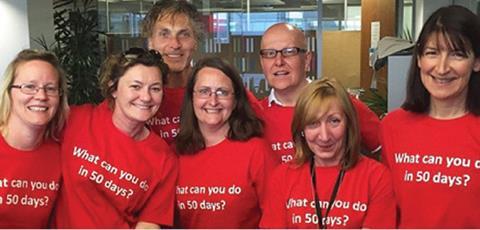
If you read nothing else, read this…
- To create a business case for a wellness scheme and demonstrate the return on investment (ROI), organisations need accurate internal baseline metrics around staff health and wellbeing.
- An effective HR technology system is key to collating and analysing what can be a huge amount of data produced by a comprehensive wellness programme.
- Employee engagement is a valuable index for monitoring ROI on wellness.
Or are they? In a report by leadership development firm Morgan Redwood, Wellbeing and business performance, published in August 2015, only 46% of respondents regarded staff health as an employer’s responsibility, in spite of 82.8% seeing the connection between business performance and staff wellbeing.
So is it a case of business leaders being unconvinced about the return on investment (ROI) in employee wellness? If so, what information do HR and benefits teams need to relay to the board to get their buy in?
Health is a business objective
Keeping a workforce healthy and productive are two key objectives for any business, whatever its size, says Brett Hill, commercial director at The Health Insurance Group. “Organisations that evaluate their wellbeing spend are more likely to continue to invest in wellbeing packages for their staff,” he says. “Monitoring and regular reporting of sickness absence rates and associated costs, including hiring temporary staff, or the cost of missed deadlines, helps to measure the effectiveness and demonstrate a return on investment of a health and wellbeing benefits package.”
Yet, producing the type of accurate internal data necessary to calculate the ROI is something that many organisations are still failing to do. John Collins, a senior consultant at Thomsons Online Benefits, says: “Take sickness absence, for example. Some [employers] still do not have a handle on their figures. They know there’s a problem, but not the size of it.
“And sickness absence is only one area that supports a wellness strategy. They also have data around private medical insurance (PMI), and employee assistance programmes [EAPs], which provide the baseline metrics. The data is there, but they need to bring it all together in a meaningful way.”
Choice of wellbeing programmes
‘What does an effective wellness scheme look like?’ is one question the board is certain to ask. In truth, there are as many schemes as there are organisations implementing them, because no two employers are the same in terms of their priorities, cultures, budgets, and demographics. The constant, however, is the need to address physical, mental and financial wellbeing, within a sustained and well-communicated programme.
Chris Evans, senior consultant at Buck Consultants at Xerox, says: “The evolution of complementary wellbeing resources from traditional employee benefits providers, alongside the growth of specialised wellbeing services, presents a huge range of choice and opportunity to design bespoke solutions within an often restricted budget.”
Conventional benefits, such as PMI, health cash plans, subsidised gym membership and EAPs, are now being complemented by sophisticated health screening programmes and wearable technology.
All-employee access
Universal access to the kinds of health screening that were once the preserve of top executives enables many more employees to have health screening within a fixed budget, says GP Dr Nick Summerton, a medical director at Bluecrest Wellness. “This has great potential for taking wellbeing strategies to a higher level in terms of impact, value and evidence of ROI,” he explains. “It enables organisations to mimic the public health plans of governments based on needs-based data, so that health and wellbeing activities can be targeted and their effects on employees can be tracked and monitored over time.”
Individual employees can get their results in digital form, through their own health apps on a smartphone or smartwatch, and measure their own progress. Organisations can collate the data anonymously and use it to identify specific issues to be addressed rather than talking in vague terms about wellbeing. They can track organisational progress over time based on hard data. For example, follow-up screenings will show reductions in weight, smoking rates, alcohol consumption, anxiety and depression.
Such a vast array of data being produced from multiple sources can be overwhelming for some organisations. Evans says: “In response, we have developed a wellbeing data dashboard into which selected data sets can be presented and monitored in a concise digestible format that will fit with the requirement for brevity at a board level.”
Board engagement
Another way of measuring ROI on wellness is through employee engagement. For example, prior to implementing its wellness strategy, online marketing agency Adtrak’s 2014 employee survey revealed that 58% of its 100 members of staff were engaged. In 2015, with the wellness scheme in place, this figure rose to 73%. Also notable was the fact that it was Adtrak’s directors that devised the wellness strategy, which includes flexi-time, a free onsite gym, a workplace breakout zone, bikes-for-work scheme, and health cash plan.

Case study: Wellbeing at Reed Business Information is led from the top

Reed Business Information’s (RBI) Living Well programme is designed to support the physical and psychological wellbeing of its 2,000 employees.
It encompasses physical fitness, healthy eating, emotional wellbeing, and giving back through a strong charity agenda. The programme is led by global marketing director, Lawrence Mitchell.
“As an ambitious [organisation] focused on innovation and growth, people are a key part of our success and we need them to be healthy and engaged in their work,” he says. ”The leadership team all understand and embrace that, and have put some resources behind the creation of the RBI Living Well programme.”
Having a voice in the executive meetings clearly helped put the topic on the agenda and frame it in a language that resonated with the leadership audience.
In making the business case and demonstrating ROI, Mitchell initially focused on sickness through absence data, using the logical argument that having a team of healthy, engaged people has to be better for business than the reverse.
It also created wellness experiences that engaged people and could be measured and reported. One of these was the RBI 50 Days of Wellbeing, which engaged 25% of employees based in the organisation’s 50 offices around the world.








